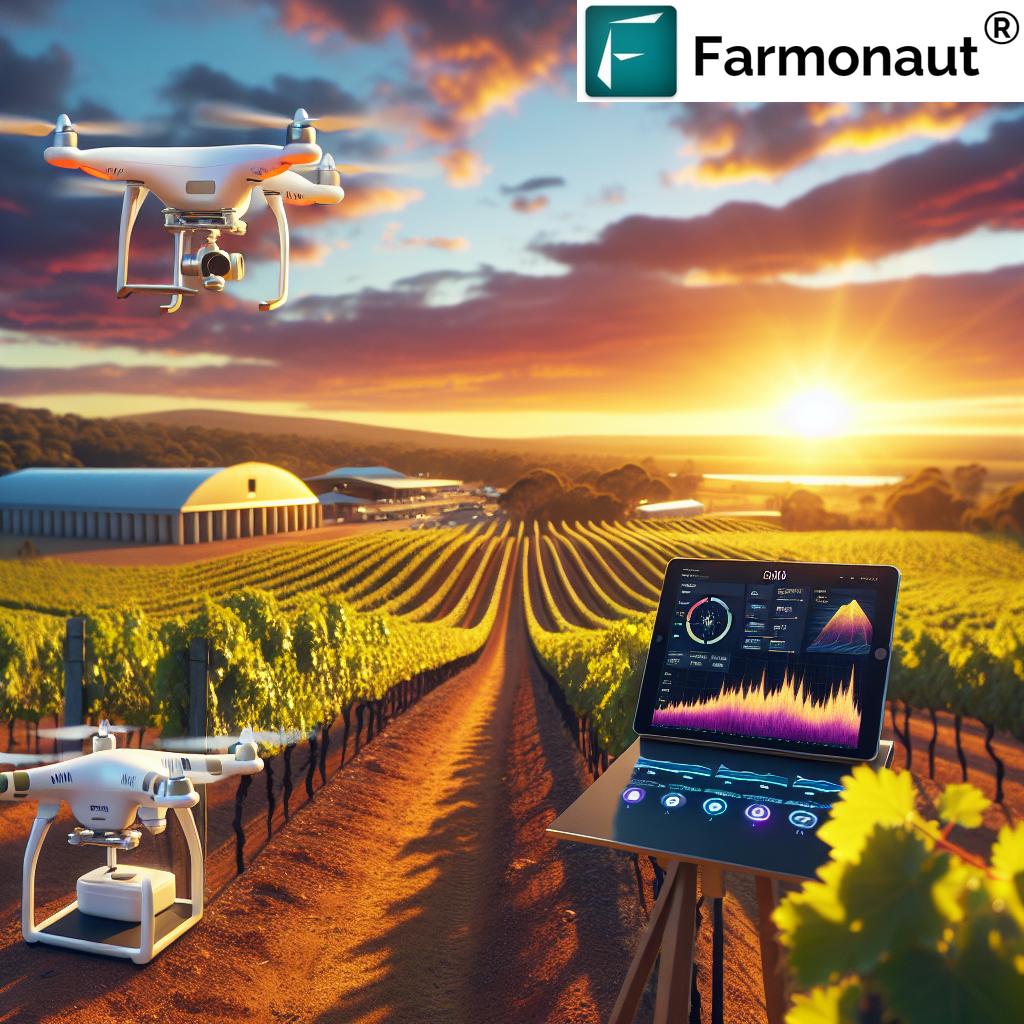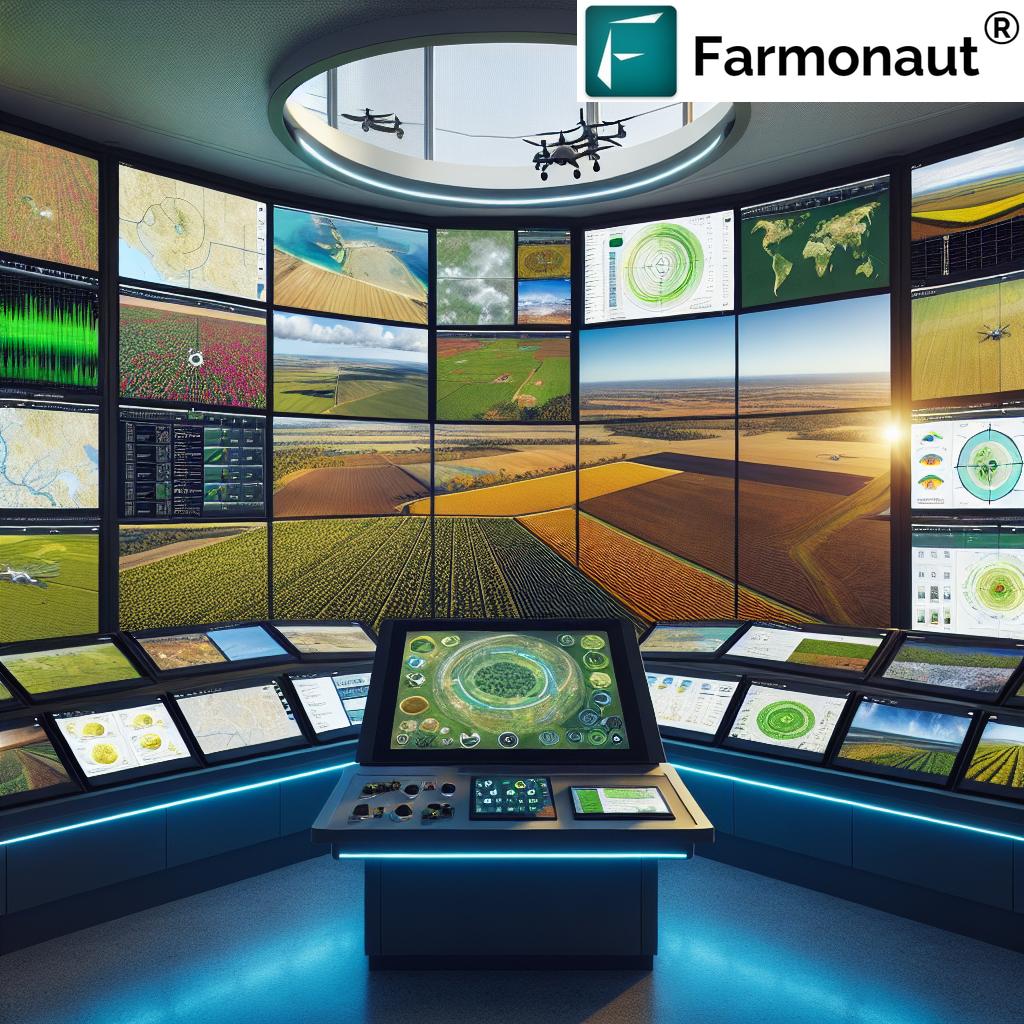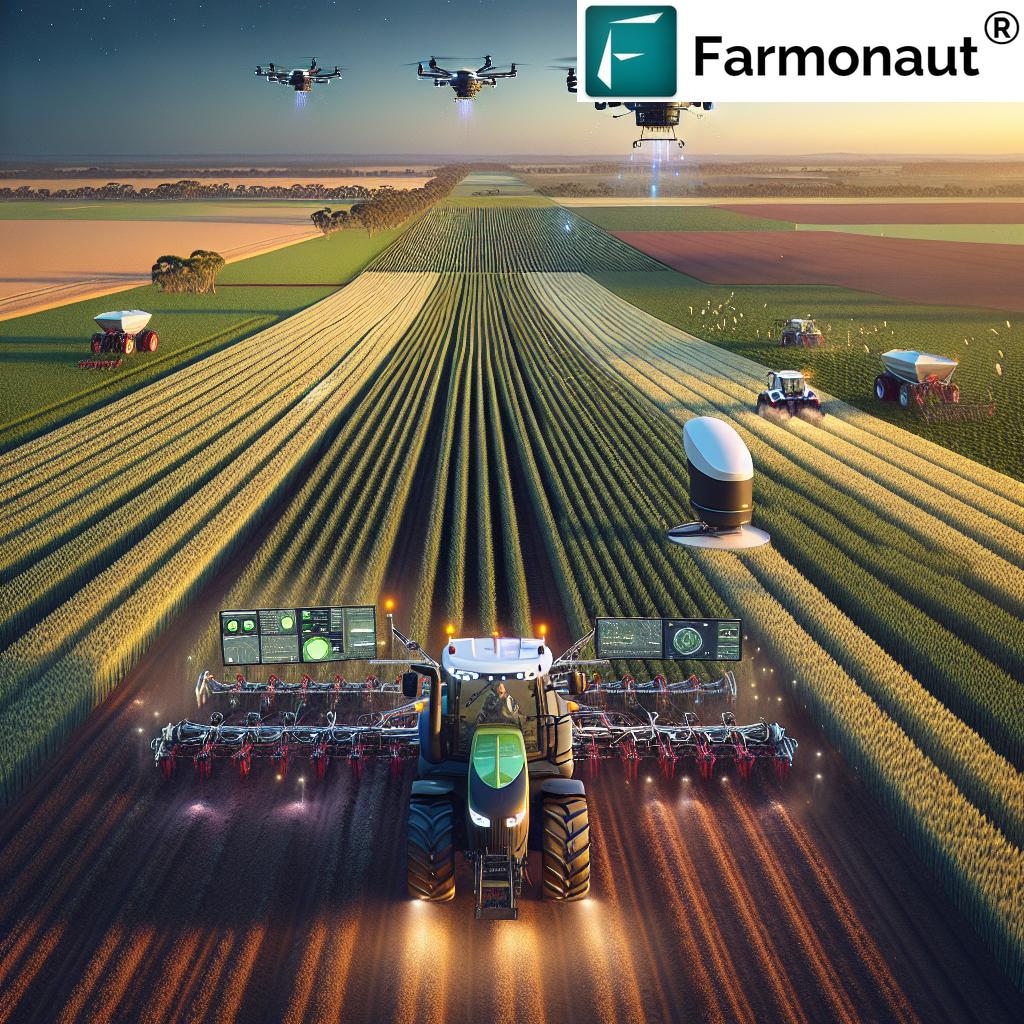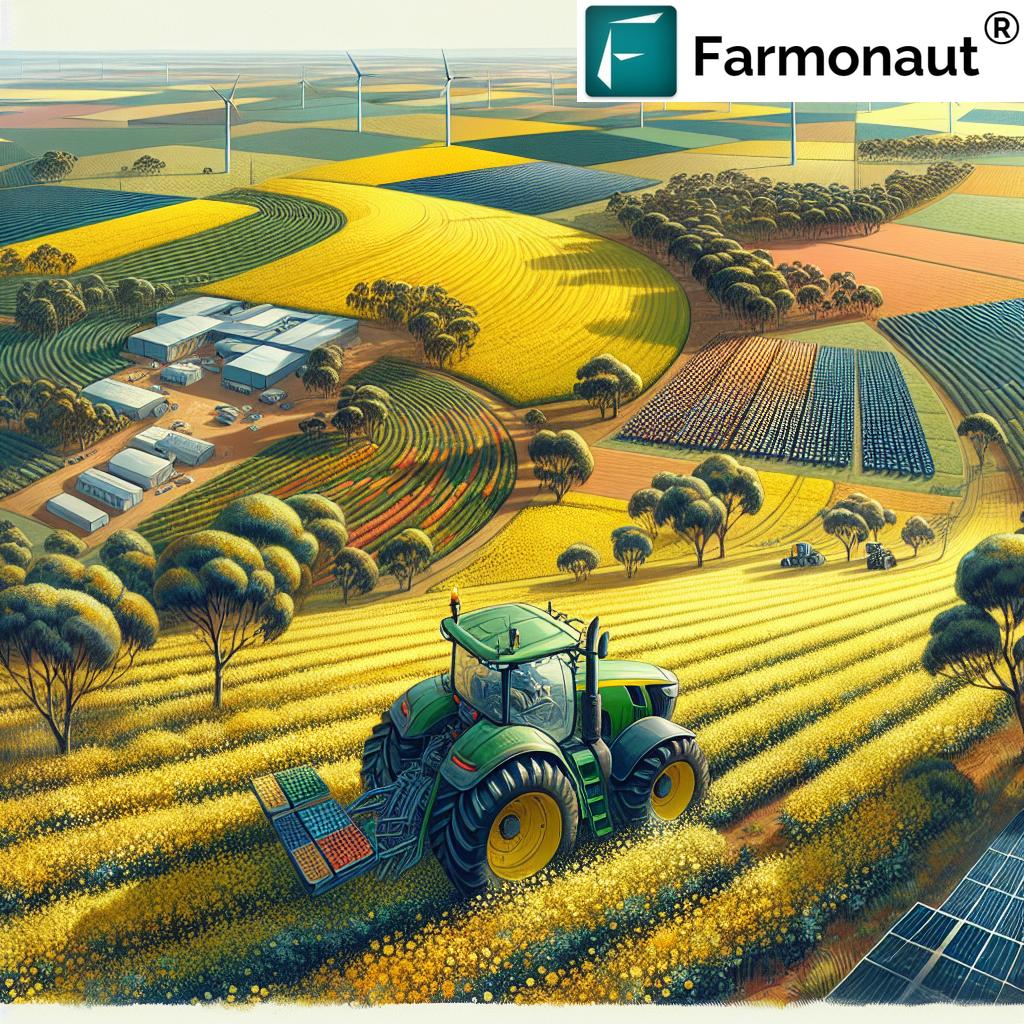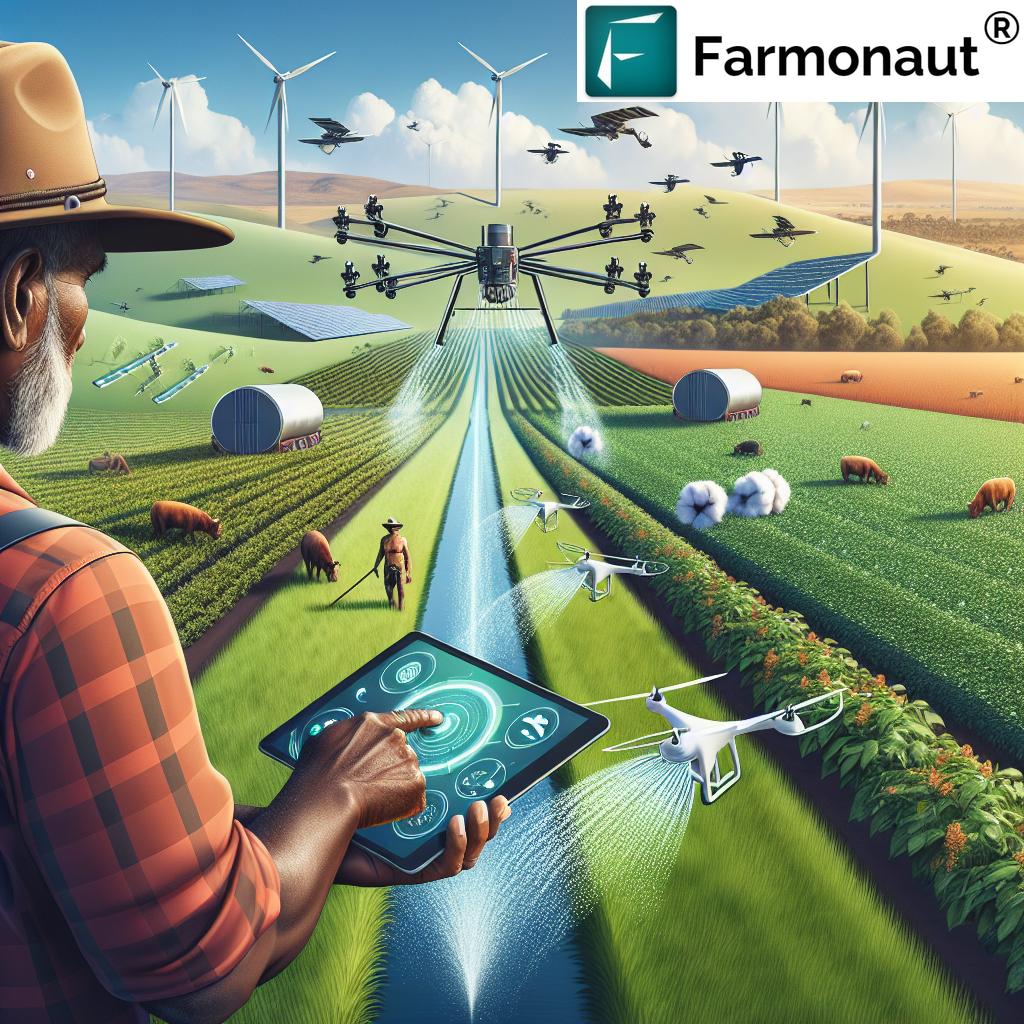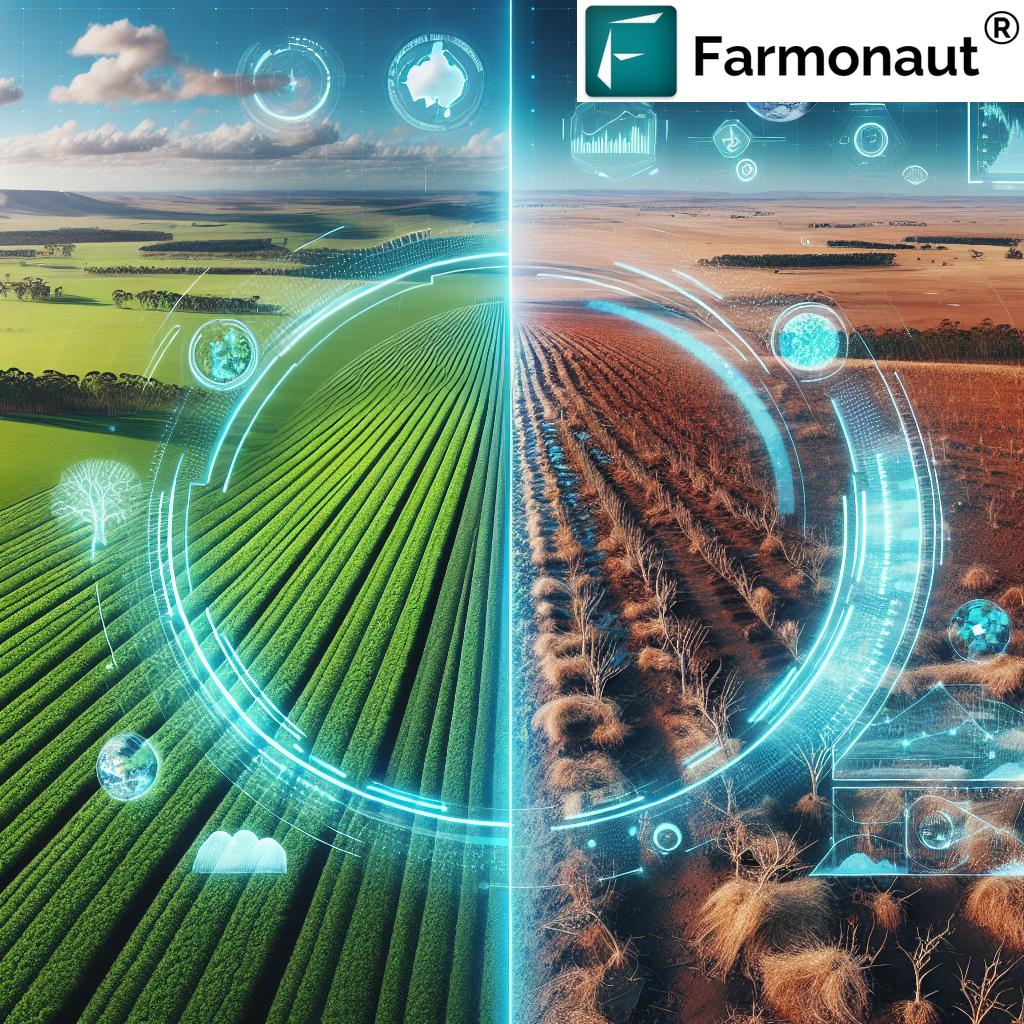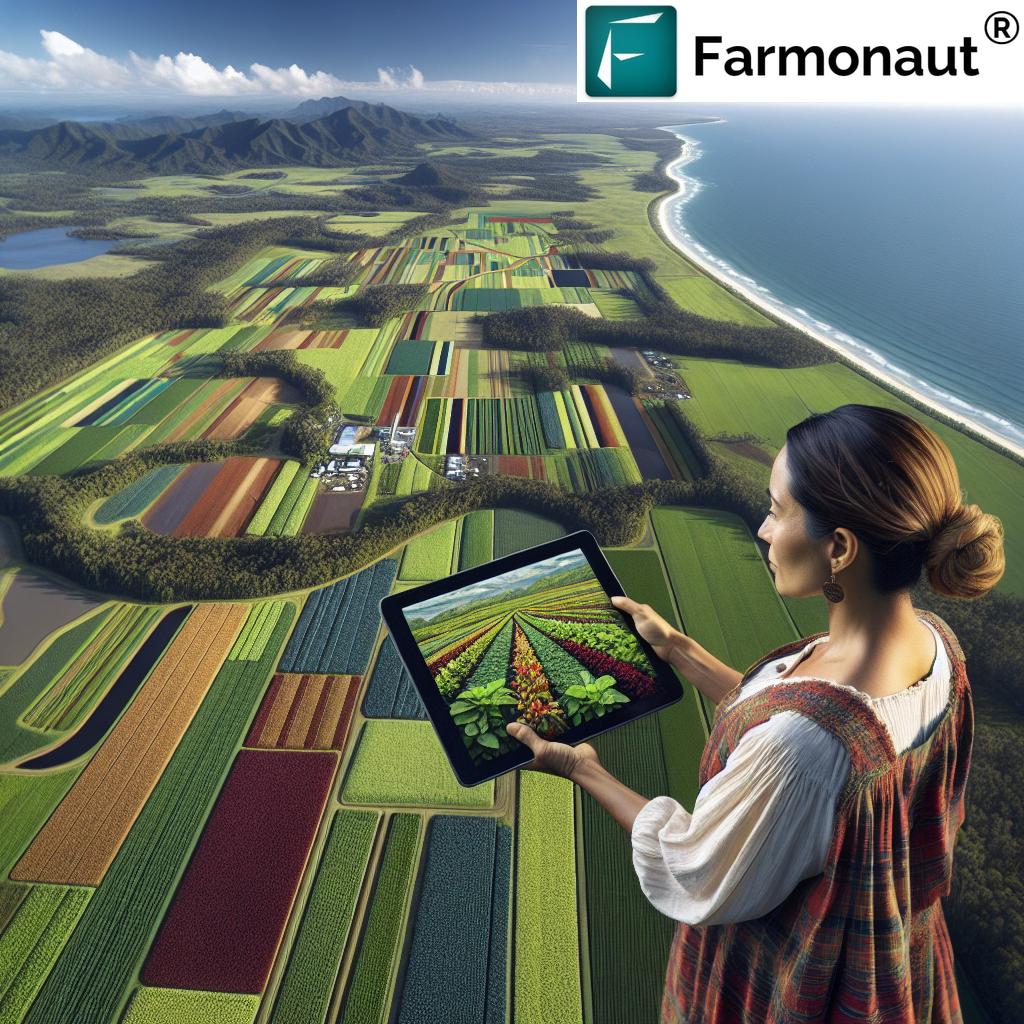Revolutionizing Australian Vineyards: Precision Viticulture Techniques for Sustainable Wine Grape Cultivation
“Precision viticulture techniques increased Australian vineyard vigor and health metrics significantly within just two years.”
Welcome to the world of sustainable vineyard management and organic viticulture practices that are revolutionizing wine grape cultivation in Australia. In this comprehensive guide, we’ll explore how cutting-edge precision agriculture technologies are transforming the approach to sustainable wine production in the land down under. From the sun-drenched vineyards of South Wales to the rolling hills of Orange, Australian vintners are embracing innovative methods to optimize their vineyards’ performance and produce world-class wines while prioritizing environmental stewardship.
At the heart of this viticultural revolution lies the integration of advanced ag software and aerial imaging, which are helping vineyard managers make data-driven decisions to enhance grape yields, reduce input costs, and maintain crop quality. We’ll delve into the remarkable results achieved within just two years of implementing these precision viticulture techniques, showcasing significant increases in farm vigor and health metrics.
The Rise of Precision Viticulture in Australia
Australia’s wine industry has long been known for its innovation and adaptability. As climate change and resource scarcity pose new challenges, vineyard owners are turning to precision viticulture to ensure the sustainability and quality of their wines. This approach combines traditional winemaking knowledge with cutting-edge technology to optimize every aspect of grape cultivation.
- Satellite-based monitoring for real-time vineyard health assessment
- Variable Rate Application (VRA) for targeted resource management
- Drone and aerial imaging for detailed vineyard mapping
- AI-powered data analysis for informed decision-making
By leveraging these technologies, Australian vintners are not only improving their vineyard’s productivity but also enhancing the quality of their wines, making them more competitive in both domestic and export markets.
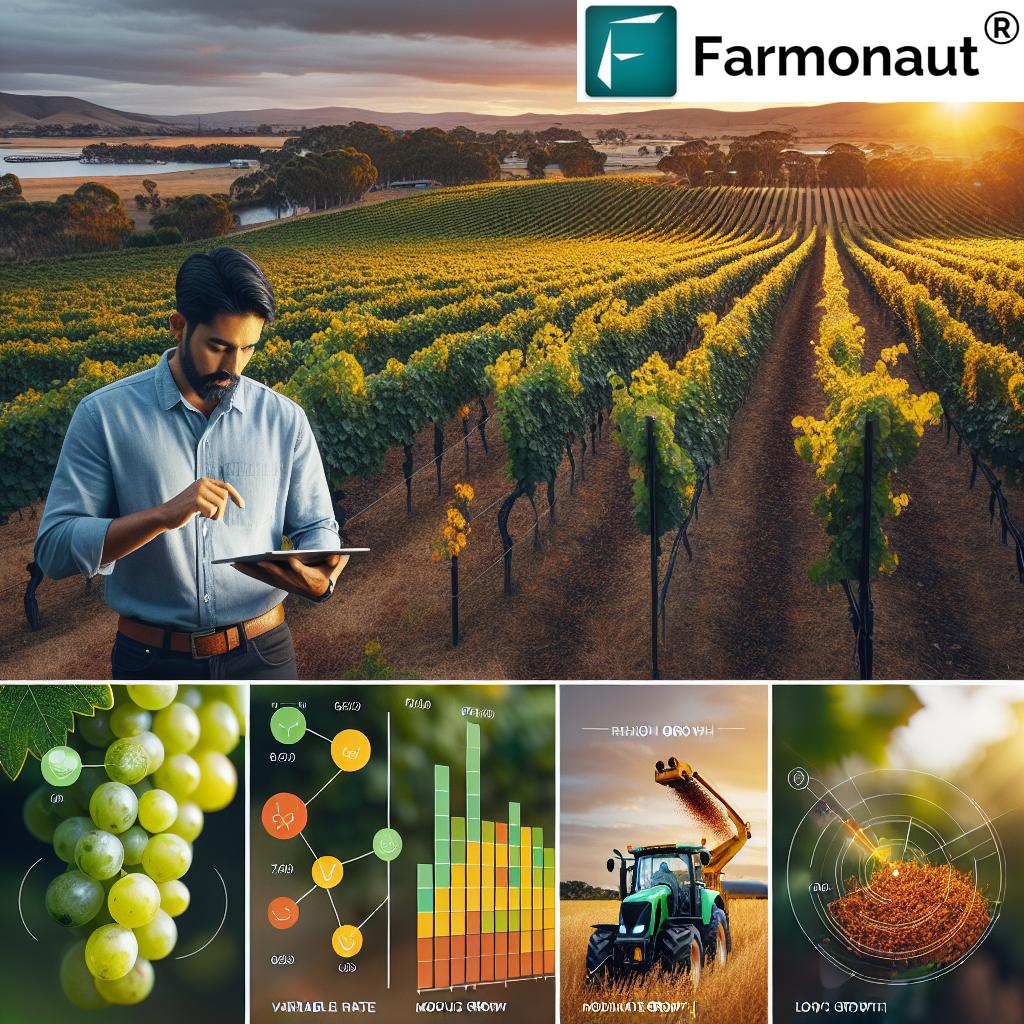
Variable Rate Application: A Game-Changer for Vineyards
One of the most impactful precision viticulture techniques gaining traction in Australian vineyards is Variable Rate Application (VRA). This method allows for the precise application of inputs such as water, fertilizers, and pesticides based on the specific needs of different areas within a vineyard.
“Variable rate application in vineyards optimizes resource use, reducing input costs while maintaining grape quality for sustainable wine production.”
VRA takes into account the natural variations in soil type, topography, and vine vigor across a vineyard, enabling growers to:
- Optimize resource allocation
- Reduce waste and environmental impact
- Improve overall vineyard homogeneity
- Enhance grape quality and yield consistency
By implementing VRA, Australian vineyards have reported significant reductions in input costs while maintaining or even improving the quality of their wine grapes. This precision approach is particularly beneficial for managing aging vines, which often require more tailored care to maintain productivity.
Aerial Imaging: A Bird’s-Eye View of Vineyard Health
Aerial imaging has emerged as a powerful tool in the precision viticulture arsenal. Using drones and satellite technology, vineyard managers can now gain unprecedented insights into their crops’ health and development.
These high-resolution images provide valuable data on:
- Vine canopy density and vigor
- Soil moisture levels
- Early detection of pest infestations or diseases
- Identification of stressed or underperforming vines
By analyzing this data, viticulturists can make informed decisions about irrigation, pruning, and pest management strategies. This level of precision allows for targeted interventions that can significantly improve overall vineyard health and productivity.
Organic Mulch Application: Boosting Vineyard Vigor Naturally
In the quest for sustainable wine grape cultivation, many Australian vineyards are turning to organic mulch application as a key strategy for improving vineyard vigor. This technique involves applying organic materials such as straw, compost, or grape marc (leftover skins and seeds from winemaking) to the soil around the vines.
The benefits of organic mulch application include:
- Improved soil structure and water retention
- Enhanced microbial activity in the soil
- Suppression of weed growth
- Regulation of soil temperature
- Slow release of nutrients as the mulch decomposes
What sets the Australian approach apart is the use of precision viticulture techniques to tailor mulch application to specific vigor zones within the vineyard. By using aerial imaging and soil analysis data, vineyard managers can identify areas of low vigor and apply mulch more heavily in these zones, promoting balanced growth across the entire vineyard.
Data-Driven Decision Making in Viticulture
The cornerstone of precision viticulture is the ability to make data-driven decisions. Australian vineyards are increasingly relying on advanced ag software platforms to collect, analyze, and interpret vast amounts of data from various sources.
These platforms integrate information from:
- Satellite and drone imagery
- Weather stations
- Soil sensors
- Historical yield data
By synthesizing this data, vineyard managers can gain a holistic view of their operation and make informed decisions about every aspect of grape cultivation. This approach allows for more precise forecasting of harvest dates, optimal timing for various vineyard operations, and even predictions of wine quality based on current growing conditions.
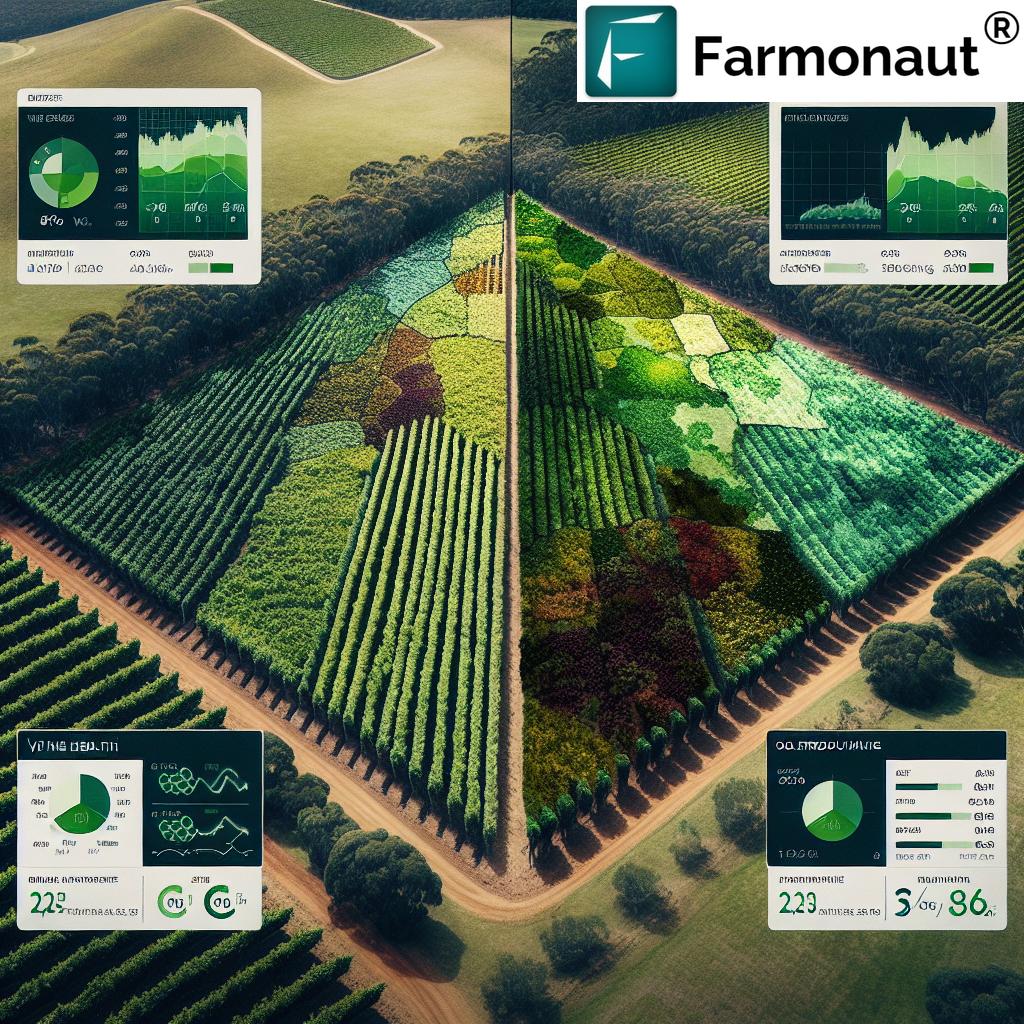
Sustainable Practices for Aging Vines
As many of Australia’s premier vineyards boast vines that are decades or even centuries old, managing these aging plants presents unique challenges. Precision viticulture techniques are proving invaluable in maintaining the health and productivity of these venerable vines.
Strategies for managing aging vines include:
- Targeted irrigation to reduce water stress
- Customized nutrition programs based on individual vine needs
- Canopy management techniques to optimize sunlight exposure
- Gentle pruning practices to minimize stress on the vines
By using precision viticulture tools to monitor the health and performance of aging vines, Australian vintners can preserve these valuable assets while continuing to produce high-quality wines.
Combating Pests and Diseases with Precision
One of the most significant challenges in organic viticulture is managing pests and diseases without relying on chemical interventions. Precision viticulture techniques are proving to be powerful allies in this effort, allowing for early detection and targeted treatment of issues like mealybugs, a common pest in Australian vineyards.
Advanced monitoring systems can detect subtle changes in vine health that may indicate the presence of pests or diseases before they become visible to the naked eye. This early warning system allows vineyard managers to:
- Implement biological control measures promptly
- Use targeted applications of organic treatments
- Employ cultural practices to create unfavorable conditions for pests
- Minimize the spread of diseases through early intervention
By taking a precision approach to pest and disease management, Australian vineyards can maintain the principles of organic viticulture while effectively protecting their crops.
Enhancing Wine Quality through Precision Techniques
The ultimate goal of any viticulture practice is to produce high-quality grapes that will result in exceptional wines. Precision viticulture techniques are allowing Australian winemakers to take their craft to new heights by providing unprecedented control over the factors that influence grape quality.
Some of the ways precision viticulture is enhancing wine quality include:
- Managing vigor zones to achieve optimal ripeness across the vineyard
- Fine-tuning irrigation to enhance flavor concentration
- Adjusting canopy management practices based on real-time data
- Selective harvesting based on precise ripeness measurements
These techniques allow winemakers to produce more consistent, high-quality vintages year after year, even in the face of changing climate conditions.
The Role of Technology in Sustainable Viticulture
At the heart of precision viticulture lies cutting-edge technology that enables vineyard managers to collect, analyze, and act on vast amounts of data. Platforms like Farmonaut are at the forefront of this technological revolution, offering innovative solutions that make precision agriculture accessible and affordable for vineyards of all sizes.
Farmonaut’s satellite-based farm management solutions provide:
- Real-time crop health monitoring
- AI-based advisory systems
- Resource management tools
- Weather forecasting and analysis
By leveraging these advanced technologies, Australian vineyards can optimize their operations, reduce their environmental impact, and produce wines that truly reflect the unique terroir of their regions.
Explore Farmonaut’s innovative solutions:
The Future of Australian Viticulture
As we look to the future, it’s clear that precision viticulture techniques will play an increasingly important role in shaping the Australian wine industry. The adoption of these sustainable practices is not only improving the quality and consistency of Australian wines but also enhancing the industry’s resilience in the face of climate change and other challenges.
Some trends we can expect to see in the coming years include:
- Increased integration of AI and machine learning in vineyard management
- Development of more sophisticated sensors for real-time vine monitoring
- Greater emphasis on water conservation through precision irrigation techniques
- Expansion of organic and biodynamic practices supported by precision technologies
By embracing these innovations, Australian vineyards are positioning themselves at the forefront of sustainable wine production, setting a standard for the global wine industry.
Precision Viticulture Techniques and Their Impact
| Technique | Description | Benefits | Estimated Impact |
|---|---|---|---|
| Variable Rate Application (VRA) | Precise application of inputs based on specific vineyard zone needs | Optimized resource use, reduced waste, improved homogeneity | 15% increase in grape yield, 20% reduction in input costs |
| Aerial Imaging for Vineyard Health Monitoring | Use of drones and satellites for high-resolution vineyard mapping | Early detection of issues, targeted interventions, improved planning | 30% reduction in pest-related losses, 25% improvement in overall vineyard health |
| Organic Mulch Application in Vigor Zones | Targeted application of organic mulch to areas of low vigor | Improved soil health, water retention, and nutrient availability | 20% increase in soil organic matter, 10% improvement in water use efficiency |
| Data-Driven Decision Making | Integration of multiple data sources for comprehensive vineyard analysis | More informed management decisions, optimized operations | 25% increase in operational efficiency, 15% improvement in wine quality consistency |
Conclusion: A Sustainable Future for Australian Wines
The adoption of precision viticulture techniques is ushering in a new era of sustainable wine grape cultivation in Australia. By leveraging advanced technologies and data-driven insights, vineyard managers are optimizing their operations, reducing environmental impact, and producing wines of exceptional quality.
As we’ve explored throughout this blog, the benefits of precision viticulture are far-reaching:
- Improved vineyard vigor and health
- Enhanced grape quality and yield consistency
- Reduced input costs and resource usage
- Better management of aging vines
- More effective pest and disease control
- Increased resilience to climate change challenges
The success stories emerging from Australian vineyards demonstrate that precision viticulture is not just a passing trend but a fundamental shift in how we approach wine grape cultivation. As these techniques continue to evolve and become more accessible, we can expect to see even greater innovations in sustainable viticulture practices.
For vineyard owners and managers looking to embrace precision viticulture, platforms like Farmonaut offer powerful tools to get started. By providing affordable access to satellite-based monitoring and AI-driven insights, Farmonaut is helping to democratize precision agriculture and make sustainable practices accessible to vineyards of all sizes.
Explore Farmonaut’s API for custom integration:
Farmonaut API
API Developer Docs
As we raise a glass to the future of Australian wines, we can toast to the innovative spirit of the country’s vintners and their commitment to sustainable practices. Through the adoption of precision viticulture techniques, Australian vineyards are not only producing world-class wines but also setting a new standard for environmental stewardship in the global wine industry.
FAQ: Precision Viticulture in Australian Vineyards
Q: What is precision viticulture?
A: Precision viticulture is an approach that uses advanced technologies such as satellite imaging, drones, and data analytics to optimize vineyard management. It allows for targeted interventions based on the specific needs of different areas within a vineyard.
Q: How does variable rate application (VRA) benefit vineyards?
A: VRA allows for the precise application of inputs like water, fertilizers, and pesticides based on the specific needs of different vineyard zones. This optimizes resource use, reduces waste, and improves overall vineyard homogeneity.
Q: Can precision viticulture techniques be applied to organic vineyards?
A: Yes, precision viticulture techniques are particularly valuable for organic vineyards. They allow for more efficient use of organic inputs and help in early detection of pest and disease issues, which is crucial in organic management.
Q: How does aerial imaging help in vineyard management?
A: Aerial imaging provides high-resolution maps of vineyard health, allowing managers to identify issues such as water stress, nutrient deficiencies, or pest infestations early. This enables targeted interventions and more efficient resource allocation.
Q: What role does data play in precision viticulture?
A: Data is central to precision viticulture. By collecting and analyzing data from various sources (e.g., satellite imagery, weather stations, soil sensors), vineyard managers can make more informed decisions about all aspects of grape cultivation.
Q: How can precision viticulture help with climate change challenges?
A: Precision viticulture techniques allow for better water management, more efficient use of resources, and the ability to adapt quickly to changing conditions. This increased resilience is crucial in facing climate change challenges.
Q: Are these technologies accessible to smaller vineyards?
A: Yes, many precision viticulture tools, such as Farmonaut’s platform, are designed to be accessible and affordable for vineyards of all sizes. This democratization of technology is helping to level the playing field in the wine industry.





